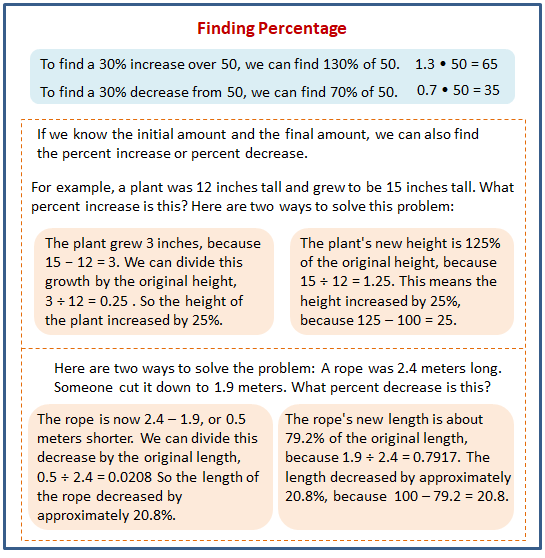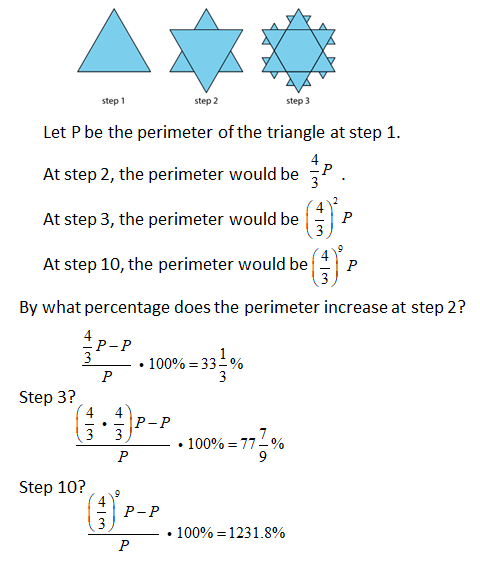Illustrative Mathematics Grade 7, Unit 4, Lesson 12: Finding the Percentage
Learning Targets:
- I can find the percentage increase or decrease when I know the original amount and the new amount.
Related Pages
Illustrative Math
Grade 7
Lesson 12: Finding the Percentage
Let’s find unknown percentages.
Illustrative Math Unit 7.4, Lesson 12 (printable worksheets)
Lesson 12 Summary
The following diagram shows how to find the percentage increase or decrease when given the original amount and the new amount.

Lesson 12.1 Tax, Tip, and Discount
What percentage of the car price is the tax?
What percentage of the food cost is the tip?
What percentage of the shirt cost is the discount?
Lesson 12.2 What Is the Percentage?
- A salesperson sold a car for $18,250 and their commission is $693.50. What percentage of the sale price is their commission?
- The bill for a meal was $33.75. The customer left $40.00. What percentage of the bill was the tip?
- The original price of a bicycle was $375. Now it is on sale for $295. What percentage of the original price was the markdown?
Are you ready for more?
To make a Koch snowflake,
Start with an equilateral triangle. This is step 1.
Divide each side into 3 equal pieces. Construct a smaller equilateral triangle on the middle third. This is step 2.
Do the same to each of the newly created sides. This is step 3.
Keep repeating this process.
By what percentage does the perimeter increase at step 2? step 3? step 10?
Lesson 12.3 Info Gap: Sporting Goods
Your teacher will give you either a problem card or a data card. Do not show or read your card to your partner.
If your teacher gives you the problem card:
- Silently read your card and think about what information you need to answer the question.
- Ask your partner for the specific information that you need.
- Explain to your partner how you are using the information to solve the problem.
- Solve the problem and explain your reasoning to your partner.
If your teacher gives you the data card: - Silently read the information on your card.
- Ask your partner “What specific information do you need?” and wait for your partner to ask for information. Only give information that is on your card. (Do not figure out anything for your partner!)
- Before telling your partner the information, ask “Why do you need that information?”
- After your partner solves the problem, ask them to explain their reasoning and listen to their explanation.
Pause here so your teacher can review your work. Ask your teacher for a new set of cards and repeat the activity, trading roles with your partner.
Lesson 12 Practice Problems
- A music store marks up the instruments it sells by 30%.
a. If the store bought a guitar for $45, what will be its store price?
b. If the price tag on a trumpet says $104, how much did the store pay for it?
c. If the store paid $75 for a clarinet and sold it for $100, did the store mark up the price by 30%? - A family eats at a restaurant. The bill is $42. The family leaves a tip and spends $49.77.
a. How much was the tip in dollars?
b. How much was the tip as a percentage of the bill? - The price of gold is often reported per ounce. At the end of 2005, this price was $513. At the end of 2015, it was $1060. By what percentage did the price per ounce of gold increase?
- A phone keeps track of the number of steps taken and the distance traveled. Based on the information in the table, is there a proportional relationship between the two quantities? Explain your reasoning.
- Noah picked 3 kg of cherries. Mai picked half as many cherries as Noah. How many total kg of cherries did Mai and Noah pick?
The Open Up Resources math curriculum is free to download from the Open Up Resources website and is also available from Illustrative Mathematics.
Try out our new and fun Fraction Concoction Game.
Add and subtract fractions to make exciting fraction concoctions following a recipe. There are four levels of difficulty: Easy, medium, hard and insane. Practice the basics of fraction addition and subtraction or challenge yourself with the insane level.

We welcome your feedback, comments and questions about this site or page. Please submit your feedback or enquiries via our Feedback page.
